Geochemical Characteristics and Environmental Implications of Surface Sediments from Different Types of Sand Dunes in the Dinggye Area, Southern Tibet
Abstract
:1. Introduction
2. Materials and Methods
2.1. Study Area
2.2. Sampling
2.3. Laboratory Measurements and Methods
2.3.1. Major and Trace Elements
2.3.2. Grain Size
2.3.3. Multidimensional Scaling
2.3.4. Principal Component Analysis
3. Results
3.1. Major Element Composition
3.2. Trace Element Composition
3.3. Differences in the Geochemical Characteristics of Surface Sediments from Different Types of Sand Dunes
4. Discussion
4.1. Factors Controlling Geochemical Compositions
4.2. Environmental Implications of the Geochemical Characteristics of Different Types of Sand Dunes in the Dinggye Area
5. Conclusions
- (1)
- The major elements are mainly SiO2, Al2O3, and CaO; SiO2 is essentially the same as UCC, and CaO is enriched; the trace elements are mainly Ba, Sr, Zr, and Rb; V, Co, As, and Pb are enriched. Mobile dunes, climbing sand sheets, and nebkhas have differences in chemical element composition and are UCC-normalized. MgO, TiO2, Ni, Pb, and Nb are present in high concentrations in mobile dunes, with higher concentrations of SiO2, CaO, K2O, Na2O, P2O5, V, Cr, Co, Cu, Ba, and Ce in climbing sand sheets; and higher Al2O3, Fe2O3, La, Zn, As, Sr, Y, Zr, Rb, and Ga in nebkhas. Compared with UCC, CaO is more enriched in climbing sand sheets, Ni, Rb, and Ga are enriched in mobile dunes and nebkhas; and Y and Zr are enriched in nebkhas.
- (2)
- An analysis of PCA showed that the five principal components explained 89.98% of the total variance. PC1 explained 45.46% of the total variance, and the elements were more significantly correlated with the coarse-grained fraction and better correlated with Mz and σ. Thus, PC1 represents the grain size characteristics and is the key factor controlling the major and trace element composition of the different types of dunes. PC2 explained 24.80% of the total variance, representing the sand source. PC3–5 also explained 9.74%, 5.97%, and 4.02% of the total variance, indicating that other factors such as chemical weathering and precipitation also influenced the elemental composition of the surface sediments.
- (3)
- Geochemical characteristics can reflect chemical weathering and provenance information. The CIA and A−CN−K triangles indicate that the different dune types are in a lower chemical weathering stage, with plagioclase weathering and decomposition first, and then Na and Ca depletion. The transport mode of aeolian sediment in the Dinggye area is mainly saltation, indicating that the sediment is mainly transported for short distances and that the provenance is mainly near the source. The combination of grain size characteristics, elemental ratios, MDS, PCA, and geomorphological conditions suggests that the flood plain is the sand source of the mobile dunes and nebkhas and that the lakeshore is the provenance of the climbing sand sheet.
Author Contributions
Funding
Conflicts of Interest
References
- Du, S.; Wu, Y.; Tan, L.; Huang, W.; Hao, C. Geochemical characteristics of fine and coarse fractions of sediments in the Yarlung Zangbo River Basin (southern Tibet, China). Environ. Earth Sci. 2018, 77, 337. [Google Scholar] [CrossRef]
- Chen, Y.; Pan, M.; Hao, Z.; Qi, Y.; Li, C. Grain size-dependent geochemical evidence reveals provenance and implications of aeolian sands, Dinggye region, southern Tibet. J. Mt. Sci. 2022, 19, 1998–2014. [Google Scholar] [CrossRef]
- Thomas, D.S.G.; Wiggs, G.F.S. Aeolian system responses to global change: Challenges of scale, process and temporal integration. Earth Surf. Process. Landf. J. Br. Geomorphol. Res. Group 2008, 33, 1396–1418. [Google Scholar] [CrossRef]
- Zhang, Z.; Liang, A.; Dong, Z.; Zhang, Z. Sand provenance in the Gurbantunggut Desert, northern China. Catena 2022, 214, 1062. [Google Scholar] [CrossRef]
- Qi, Y.; Pan, M.; Hao, Z.; Yang, A.; Xue, W. Variations in aeolian landform patterns in the Gonghe Basin over the last 30 years. J. Mt. Sci. 2021, 18, 2034–2047. [Google Scholar] [CrossRef]
- Du, S.; Wu, Y.; Tan, L. Geochemical evidence for the provenance of aeolian deposits in the qaidam basin, tibetan plateau. Aeolian Res. 2018, 32, 60–70. [Google Scholar] [CrossRef]
- Zhang, Z.; Pan, K.; Zhang, C.; Liang, A. Geochemical characteristics and the provenance of aeolian material in the Hexi Corridor Desert, China. Catena 2020, 190, 104483. [Google Scholar] [CrossRef]
- Ren, X.Z.; Yang, X.P.; Wang, Z.T.; Zhu, B.Q.; Zhang, D.G.; Rioual, P. Geochemical evidence of the sources of aeolian sands and their transport pathways in the Minqin Oasis, northwestern China. Quat. Int. 2014, 334, 165–178. [Google Scholar] [CrossRef]
- Bosq, M.; Bertran, P.; Degeai, J.P.; Queffelec, A.; Moine, O. Geochemical signature of sources, recycling and weathering in the Last Glacial loess from the Rhône Valley (southeast France) and comparison with other European regions. Aeolian Res. 2020, 42, 100561. [Google Scholar] [CrossRef]
- Chen, G.; Dong, Z.; Li, C.; Shi, W.; Shao, T.; Nan, W.; Yang, J. Provenance of Aeolian Sediments in the Ordos Deserts and Its Implication for Weathering, Sedimentary Processes. Front. Earth Sci. 2021, 9, 544. [Google Scholar] [CrossRef]
- Muhs, D. Mineralogicai maturity in dunefields of North America’Africa and Australia. Geomorphology 2004, 59, 247–269. [Google Scholar] [CrossRef]
- Weltje, G.J.; Eynatten, H. Quantitative provenance analysis of sediments: Review and outlook. Sediment Geol. 2004, 171, 1–11. [Google Scholar] [CrossRef]
- An, C.B.; Feng, Z.D.; Barton, L. Dry or humid? Mid-Holocene humidity changes in arid and semi-arid China. Quat. Sci. Rev. 2006, 25, 351–361. [Google Scholar] [CrossRef]
- Garzanti, E.; Vezzoli, G.; Andò, S.; Lavé, J.; Attal, M.; France-Lanord, C.; DeCelles, P. Quantifying sand provenance and erosion (Marsyandi River, Nepal Himalaya). Earth Planet. Sci. Lett. 2007, 258, 500–515. [Google Scholar] [CrossRef]
- Li, Y.; Gholami, H.; Song, Y.G.; Fathabadi, A.; Malakooti, H.; Collins, A.L. Source fingerprinting loess deposits in Central Asia using elemental geochemistry with Bayesian and GLUE models. Catena 2020, 194, 104808. [Google Scholar] [CrossRef]
- Yan, P.; Li, X.M.; Ma, Y.F.; Wu, W.; Qian, Y. Morphological characteristics of interactions between deserts and rivers in northern China. Aeolian Res. 2015, 19, 225–233. [Google Scholar] [CrossRef]
- Muhs, D.R. Evaluation of simple geochemical indicators of aeolian sand provenance: Late Quaternary dune fields of North America revisited. Quat. Sci. Rev. 2017, 171, 260–296. [Google Scholar] [CrossRef]
- Lehmkuhl, F.; Haselein, F. Quaternary paleoenvironmental change on the Tibetan plateau and adjacent areas (western china and western mongolia). Quat. Int. 2000, 65, 121–145. [Google Scholar] [CrossRef]
- An, F.Y.; Ma, H.Z.; Wei, H.C.; Lai, Z.P. Distinguishing aeolian signature from lacustrine sediments of the Qaidam Basin in northeastern Qinghai-Tibetan Plateau and its palaeoclimatic implications. Aeolian Res. 2012, 4, 17–30. [Google Scholar] [CrossRef]
- Liu, B.; Jin, H.L.; Sun, Z.; Su, Z.Z.; Zhang, C.X. Holocene millennial-scale climate change revealed by wind-deposited trace elements in the northeastern Tibetan Plateau. J. Paleogeogr. 2013, 15, 423–433. [Google Scholar] [CrossRef]
- Dong, Z.; Hu, G.; Qian, G.; Lu, J.; Zhang, Z.; Luo, W. High-Altitude Aeolian Research on the Tibetan Plateau. Rev. Geophys. 2017, 55, 864–901. [Google Scholar] [CrossRef]
- Kaiser, K.; Lai, Z.; Schneider, B.; Reudenbach, C.; Miehe, G.; Brückner, H. Stratigraphy and palaeoenvironmental implications of pleistocene and holocene aeolian sediments in the lhasa area, southern tibet (china). Palaeogeogr. Palaeoclimatol. Palaeoecol. 2009, 271, 329–342. [Google Scholar] [CrossRef]
- Pan, M.H.; Wu, Y.Q.; Zheng, Y.H.; Tan, L.H. Holocene aeolian activity in the Dinggye area (Southern Tibet, China). Aeolian Res. 2014, 12, 19–27. [Google Scholar] [CrossRef]
- Ma, J.J.; Pan, M.H.; Wu, Y.Q.; Xue, W.X. Geomorphological pattern and its change of aeolian landform in Dingjie area of Tibet from 1996 to 2016. Arid Land Geogr. 2018, 41, 1035–1042. (In Chinese) [Google Scholar] [CrossRef]
- Pan, M.H.; Xue, W.X.; Wu, Y.Q.; Huang, W.M.; Ma, J.J.; Yang, A.N.; Chen, Y.L. Grain size characteristics of the climbing dunes in Dinggye area of Tibet. Arid Land Geogr. 2019, 42, 1337–1345. (In Chinese) [Google Scholar] [CrossRef]
- Hou, L.; Shan, X.; Gong, W.; Zhang, Y.; Luo, H.; Zhao, D. Characterizing seismogenic fault of 2016 Dingjie earthquake based on multiemporal DInSAR. Chin. J. Geophys. 2020, 63, 1357–1369. (In Chinese) [Google Scholar]
- Ye, Y.Q.; Yang, Z.; Di, B.F.; Tang, D.H.; Wang, C.J.; Tang, J. Grassland resources and sustainable development of animal husbandry in Dingjie County, Tibet. Mt. Res. 2003, 3, 337–341. (In Chinese) [Google Scholar] [CrossRef]
- Jia, W. Soil geography of the Yarlung River basin, Dinggye Basin, Tibet. Chin. J. Soil Sci. 1964, 2, 20–24. (In Chinese) [Google Scholar]
- Pan, M.H.; Hao, Z.W.; Qi, Y.H.; Yang, A.N.; Chen, Y.G.; Li, C.L. Grain size characteristics of moving dune in different geomorphologicallocations in Pengqu Basin, Tibet, China. J. Desert Res. 2021, 41, 138. (In Chinese) [Google Scholar] [CrossRef]
- Nesbitt, H.W.; Young, G.M. Early Proterozoic climates and plate motions inferred from major element chemistry of lutites. Nature 1982, 299, 715–717. [Google Scholar] [CrossRef]
- McLennan, S.M. Weathering and global denudation. J. Geol. 1993, 101, 295–303. [Google Scholar] [CrossRef]
- Lu, H.; An, Z. Experimental study of the effect of pre-treatment methods on particle size measurements in loess sediments. Chin. Sci. Bull. 1997, 23, 2535–2538. [Google Scholar] [CrossRef] [Green Version]
- Folk, R.L.; Ward, W.C. Brazos river bar:a study in the significance of grain size parameter. J. Sediment Res. 1957, 27, 3–26. [Google Scholar] [CrossRef]
- Stevens, T.; Carter, A.; Watson, T.P.; Vermeesch, P.; Lu, H.; Andò, S.; Garzanti, E.; Cottam, M.A.; Sevastjanova, I.; Rittner, M. Genetic linkage between the Yellow River, the Mu Us desert and the Chinese Loess Plateau. Quat. Sci. Rev. 2013, 78, 355–368. [Google Scholar] [CrossRef]
- Kruskal, J.B. Multidimensional scaling by optimizing goodness of fit to a nonmetrichypothesis. Psychometrika 1964, 29, 1–27. [Google Scholar] [CrossRef]
- Wold, S.; Esbensen, K.; Geladi, P. Principal component analysis. Chemom. Intell. Lab. Syst. 1987, 2, 37–52. [Google Scholar] [CrossRef]
- Shi, J.; Liu, X. Melt Index Prediction by Neural Soft-Sensor Based on Multi-Scale Analysis and Principal Component Analysis. Chin. J. Chem. Eng. 2005, 13, 849–852. [Google Scholar] [CrossRef]
- Taylor, S.R.; McLennan, S.M. The Continenal Crust: Its Compo-Sition and Evolution; Blackwell Scientific: Boston, MA, USA, 1985. [Google Scholar]
- Wang, X.; Hua, T.; Zhu, B.; Lang, L.; Zhang, C. Geochemical characteristics of the fine-grained component of surficial deposits from dust source areas in northwestern china. Aeolian Res. 2018, 34, 18–26. [Google Scholar] [CrossRef]
- Rao, W.; Tan, H.; Jiang, S.; Chen, J. Trace element and REE geochemistry of fine-and coarse-grained sands in the Ordos deserts and links with sediments in surrounding areas. Geochemistry 2011, 71, 155–170. [Google Scholar] [CrossRef]
- Hu, F.; Yang, X. Geochemical and geomorphological evidence for the provenance of Aeolian deposits in the Badain Jaran Desert, northwestern China. Quat. Sci. Rev. 2016, 131, 179–192. [Google Scholar] [CrossRef]
- Dong, M.; Yan, P.; Meng, S.N.; Wu, W. Characterization of surface sediments of climbing sand dunes on the Qinghai-Tibet Plateau—Torahai River in the Qaidam Basin as an example. J. Soil Water Conserv. 2018, 32, 101–108. [Google Scholar] [CrossRef]
- Liu, Q.; Yang, X. Geochemical composition and provenance of aeolian sands in the Ordos deserts, northern china. Geomorphology 2018, 318, 354–374. [Google Scholar] [CrossRef]
- Ling, Z.; Li, J.; Jin, J.; Wang, J.; Kong, F.; Chen, L. Geochemical characteristics and provenance of aeolian sediments in the Yarlung Tsangpo valley, Southern Tibetan Plateau. Environ. Earth Sci. 2021, 80, 623. [Google Scholar] [CrossRef]
- Anisimov, I.; Sagitova, A.; Troshina, O.; Agapov, I. Mineral-Geochemical Criteria to Gold and Silver Recovery for Geometallurgical Sampling Campaign on Primorskoe Gold-Silver Deposit. In International Congress on Applied Mineralogy; Springer: Cham, Switzerland, 2019; pp. 19–23. [Google Scholar] [CrossRef]
- Yang, X.P.; Zhu, B.P.; White, P.D. Provenance of aeolian sediment in the Taklamakan Desert of western China, inferred from REE and major-elemental data. Quat. Int. 2007, 175, 71–85. [Google Scholar] [CrossRef]
- Liu, B.; Jin, H.L.; Miao, Y.F.; Sun, Z.; Su, Z.Z.; Zhang, C.X. Evidence of Holocene millennial-scale climatic change from Gonghe Basin peat deposit, northeastern Qinghai-Tibet Plateau. J. Arid Environ. 2014, 106, 1–10. [Google Scholar] [CrossRef]
- Yu, K.; Lehmkuhl, F.; Diekmann, B.; Zeeden, C.; Nottebaum, V.; Stauch, G. Geochemical imprints of coupled paleoenvironmental and provenance change in the lacustrine sequence of Orog Nuur, Gobi Desert of Mongolia. J. Paleolimnol. 2017, 58, 511–532. [Google Scholar] [CrossRef]
- Yang, X.C.; Cai, M.T.; Ye, P.S.; Li, C.L.; Wu, H.; Lu, J.; Wang, T.; Zhao, Z.R.; Liu, C. Provenance of aeolian sands in the Hetao Plain, northwestern China. Aeolian Res. 2018, 32, 92–101. [Google Scholar] [CrossRef]
- Qiang, M.R.; Chen, F.H.; Wang, Z.T.; Niu, G.M.; Song, L. Aeolian deposits at the southeastern margin of the Tengger Desert (China): Implications for surface wind strength in the Asian dust source area over the past 20,000 years. Palaeogeogr. Palaeocl. 2010, 286, 66–80. [Google Scholar] [CrossRef]
- Ding, Z.; Sun, S.; Yang, T.; Liu, T. Geochemistry of the Pliocene red clay formation in the Chinese Loess Plateau and implications for its origin, source provenance and paleoclimate change. Geochim. Cosmochim. Acta 2001, 65, 901–913. [Google Scholar] [CrossRef]
- Zhang, Z.; Liang, A.; Zhang, C.; Dong, Z. Gobi deposits play a significant role as sand sources for dunes in the Badain Jaran Desert, Northwest China. Catena 2021, 206, 105530. [Google Scholar] [CrossRef]
- Zhang, Z.; Jia, Y.L. Different provenance of separate loess sites in Yangtze River Basin and its paleoenvironmental implications. J. Mt. Sci. 2019, 16, 1616–1628. [Google Scholar] [CrossRef]

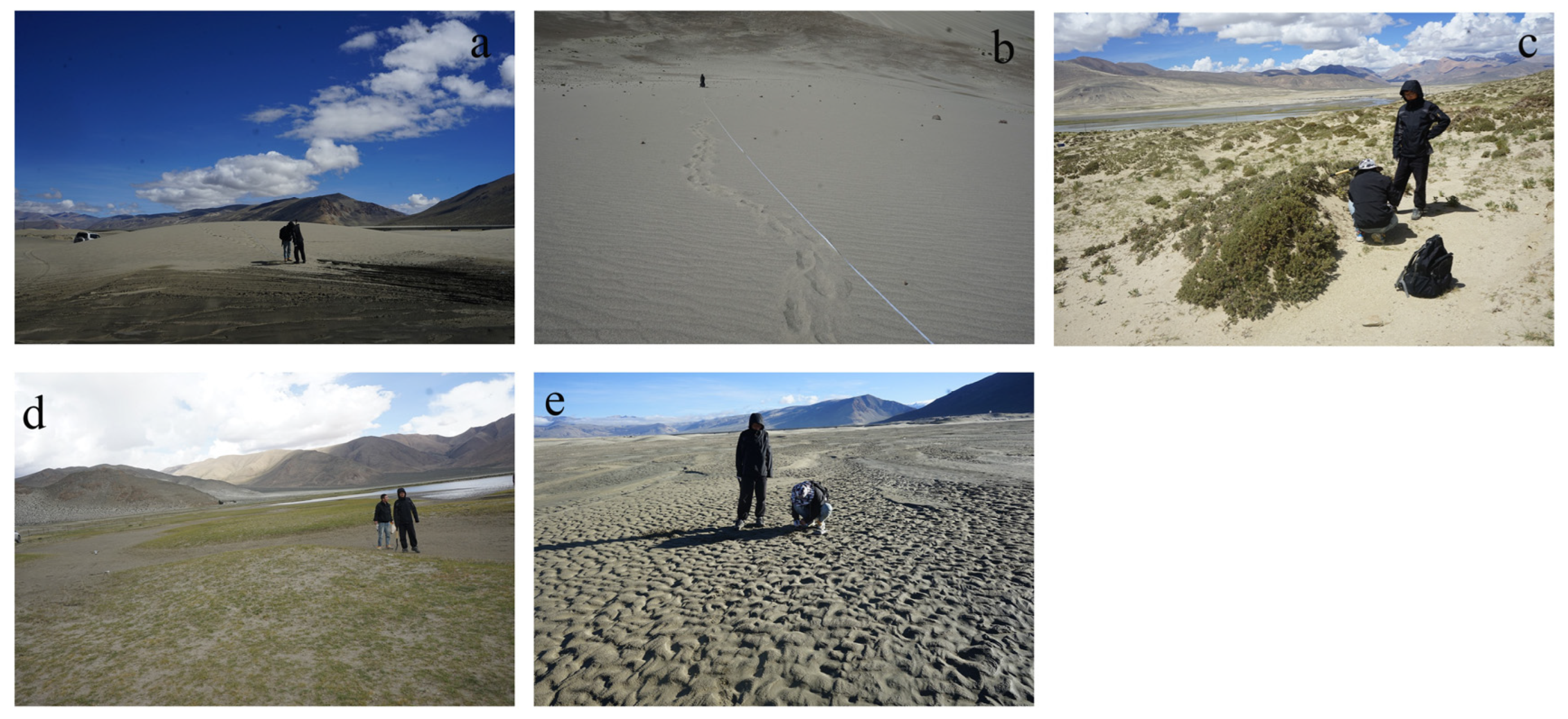
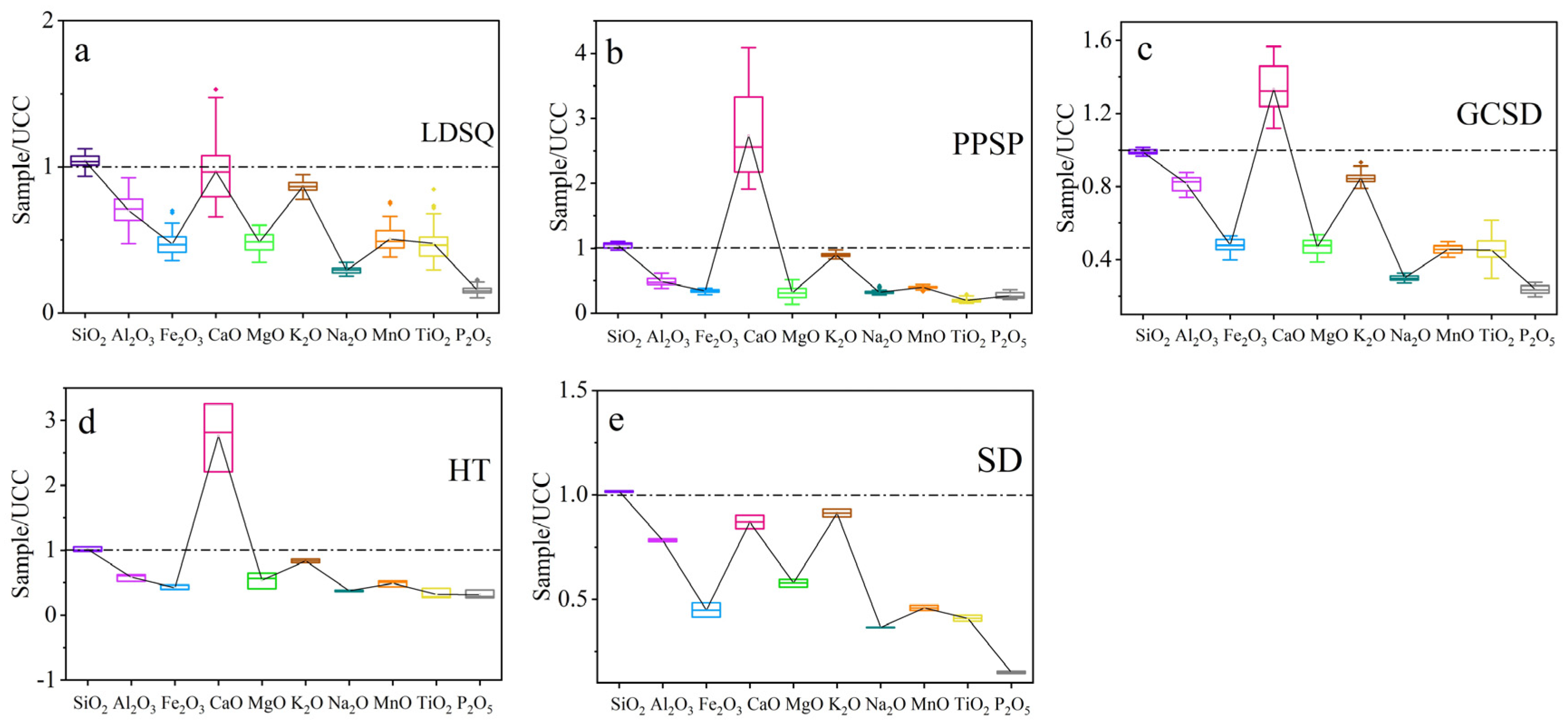
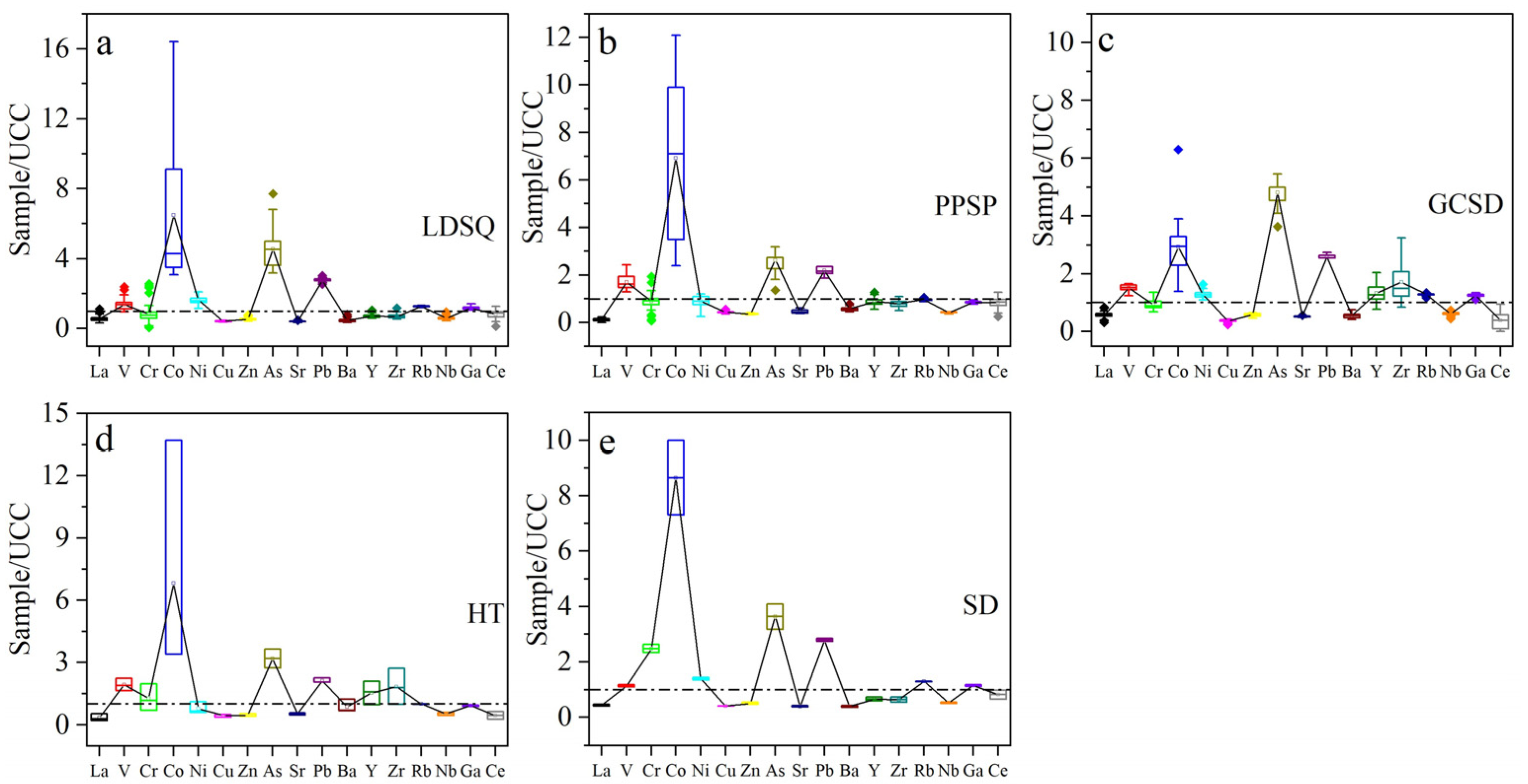
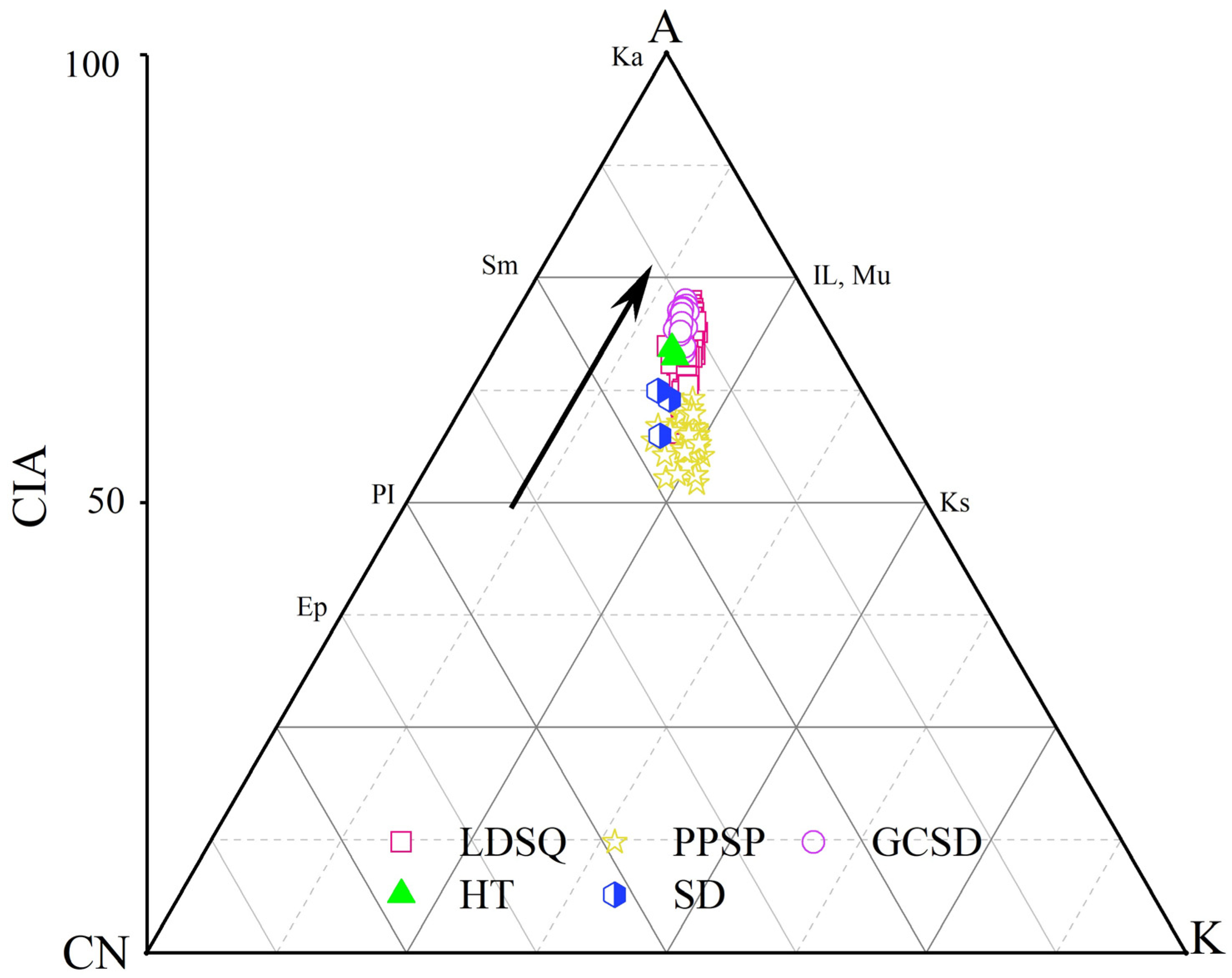
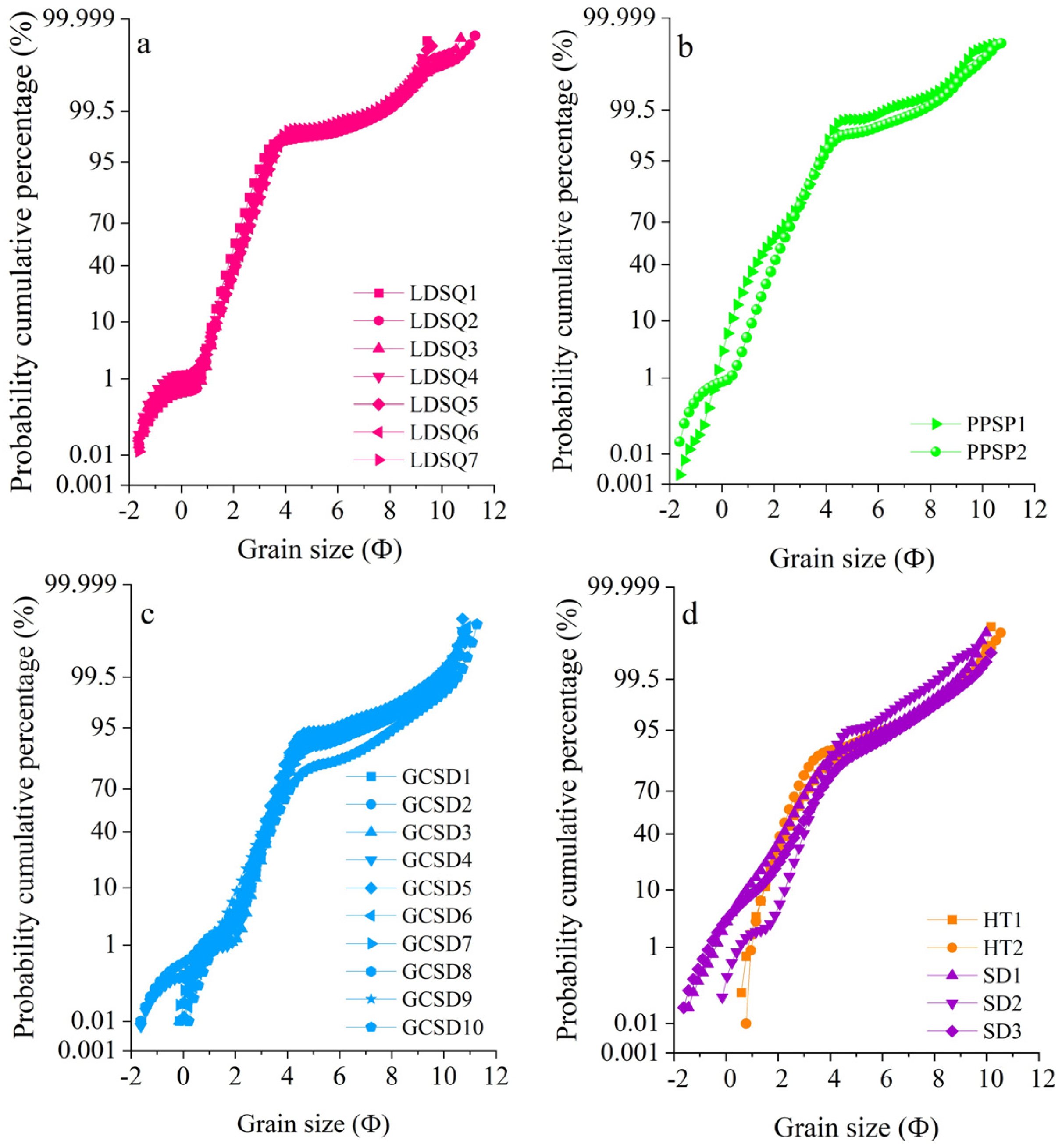
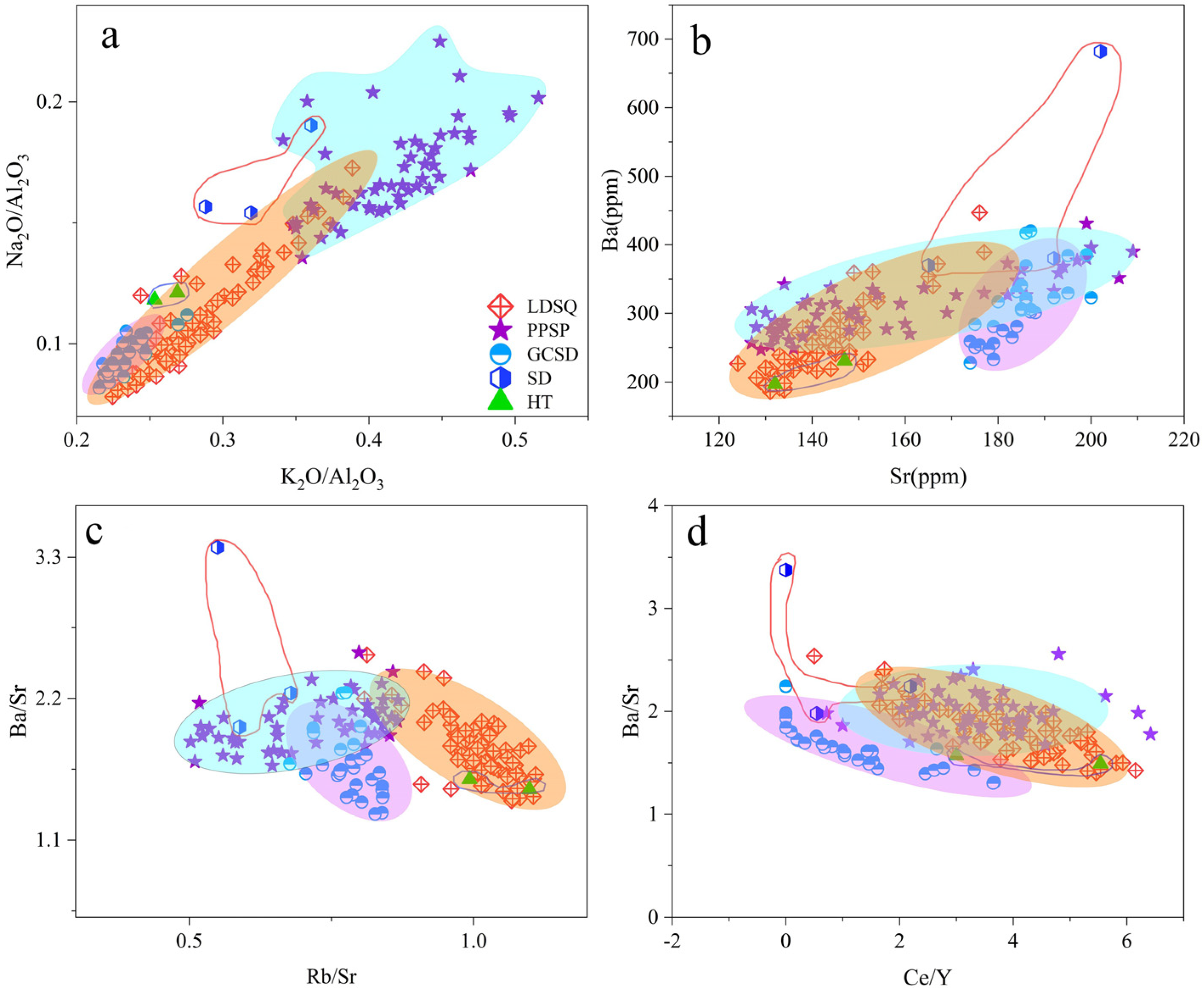

| Major Elements | Samples | |||||||||
|---|---|---|---|---|---|---|---|---|---|---|
| Mobile Dunes (n = 71) | Climbing Sand Sheets (n = 53) | Nebkhas (n = 30) | Flood Plain (n = 2) | Lakeshore (n = 3) | ||||||
| Mean | CV | Mean | CV | Mean | CV | Mean | CV | Mean | CV | |
| SiO2 | 68.63 | 4.03 | 69.14 | 3.69 | 65.29 | 1.41 | 67.08 | 0.52 | 66.90 | 3.57 |
| Al2O3 | 10.64 | 14.62 | 7.42 | 11.82 | 12.39 | 5.22 | 11.79 | 1.25 | 8.87 | 9.78 |
| CaO | 4.06 | 15.45 | 11.47 | 24.40 | 5.60 | 10.15 | 3.66 | 5.22 | 11.58 | 19.03 |
| Fe2O3 | 2.36 | 15.69 | 1.71 | 7.08 | 2.40 | 7.19 | 2.24 | 10.73 | 2.11 | 8.78 |
| MgO | 1.06 | 13.55 | 0.69 | 28.17 | 1.03 | 9.68 | 1.27 | 4.45 | 1.87 | 22.25 |
| K2O | 2.95 | 3.97 | 3.05 | 3.95 | 2.88 | 3.63 | 3.11 | 2.96 | 2.84 | 3.52 |
| Na2O | 1.14 | 7.99 | 1.26 | 9.30 | 1.17 | 5.13 | 1.43 | 0.50 | 1.47 | 2.97 |
| TiO2 | 0.24 | 22.62 | 0.10 | 14.86 | 0.23 | 16.69 | 0.20 | 5.08 | 0.16 | 24.81 |
| MnO | 0.03 | 16.07 | 0.02 | 5.60 | 0.03 | 5.47 | 0.03 | 3.85 | 0.03 | 9.68 |
| P2O5 | 0.08 | 17.12 | 0.14 | 17.61 | 0.12 | 9.88 | 0.07 | 5.38 | 0.16 | 20.73 |
| CIA | 66.74 | 5.43 | 56.95 | 4.02 | 70.35 | 1.99 | 66.64 | 1.01 | 60.44 | 4.38 |
| Trace Elements | Samples | |||||||||
|---|---|---|---|---|---|---|---|---|---|---|
| Mobile Dunes (n = 71) | Climbing Sand Sheets (n = 53) | Nebkhas (n = 30) | Flood Plain (n = 2) | Lakeshore (n = 3) | ||||||
| Mean | VC | Mean | VC | Mean | VC | Mean | VC | Mean | VC | |
| La | 18.06 | 27.50 | 3.81 | 56.98 | 18.13 | 19.84 | 14.00 | 10.10 | 10.67 | 53.31 |
| V | 82.20 | 21.22 | 102.23 | 17.74 | 90.83 | 7.58 | 68.50 | 5.16 | 116.00 | 15.59 |
| Cr | 29.37 | 55.11 | 31.00 | 38.26 | 32.83 | 17.03 | 87.00 | 813 | 44.67 | 50.87 |
| Co | 64.87 | 56.15 | 69.15 | 43.98 | 29.37 | 29.60 | 86.50 | 22.07 | 68.33 | 87.03 |
| Ni | 32.65 | 12.84 | 17.75 | 26.28 | 25.87 | 9.51 | 28.00 | 5.05 | 15.67 | 35.15 |
| Cu | 10.77 | 7.56 | 10.81 | 8.12 | 9.33 | 14.71 | 10.00 | 0 | 11.00 | 15.75 |
| Zn | 38.13 | 14.00 | 25.23 | 5.80 | 41.13 | 9.33 | 36.00 | 11.79 | 31.67 | 14.92 |
| As | 10.04 | 23.29 | 5.77 | 15.43 | 10.60 | 9.47 | 8.00 | 17.68 | 7.00 | 14.29 |
| Sr | 143.13 | 7.20 | 156.43 | 16.32 | 184.33 | 3.78 | 139.50 | 7.60 | 186.33 | 10.27 |
| Pb | 28.30 | 3.98 | 22.32 | 6.07 | 26.70 | 20.04 | 28.50 | 2.48 | 21.67 | 5.33 |
| Ba | 259.70 | 19.73 | 312.26 | 13.58 | 307.27 | 16.54 | 214.00 | 11.23 | 477.33 | 37.15 |
| Y | 15.62 | 14.61 | 19.30 | 16.21 | 29.47 | 27.85 | 14.50 | 14.63 | 34.00 | 36.85 |
| Zr | 133.04 | 17.16 | 152.66 | 17.72 | 326.50 | 38.90 | 121.00 | 21.04 | 346.67 | 47.65 |
| Rb | 143.17 | 2.16 | 107.89 | 3.59 | 144.37 | 26.20 | 145.50 | 0.49 | 112.00 | 0.89 |
| Nb | 11.97 | 17.35 | 8.26 | 5.89 | 12.37 | 11.92 | 10.50 | 6.73 | 10.67 | 14.32 |
| Ga | 19.90 | 6.42 | 14.23 | 5.45 | 21.43 | 5.15 | 19.50 | 3.62 | 15.67 | 3.69 |
| Ce | 58.94 | 26.02 | 61.02 | 23.24 | 28.90 | 80.85 | 60.00 | 28.28 | 32.50 | 58.74 |
| Dunes | Differences | Similarities |
|---|---|---|
| Mobile dunes | MgO, TiO2, Ni, Pb, and Nb are higher; Ni, Rb, and Ga are enriched | SiO2 and CaO are enriched in major elements and other elements are depleted; V, Co, As, and Pb are enriched in trace elements |
| Climbing sand sheets | SiO2, CaO, K2O, Na2O, P2O5, V, Cr, Co, Cu, Ba, and Ce are higher; Cr, Ni, Rb, and Ce are consistent with UCC | |
| Nebkhas | Al2O3, Fe2O3, La, Zn, As, Sr, Y, Zr, Rb, and Ga are higher; V, Co, Y, Zr, Ni, Rb, and Ga are enriched; Cr is consistent with UCC |
| Element/Oxide | Component | ||||
|---|---|---|---|---|---|
| PC1 | PC2 | PC3 | PC4 | PC5 | |
| SiO2 | −0.384 | −0.813 | −0.282 | 0.153 | 0.134 |
| Al2O3 | 0.858 | 0.351 | 0.115 | −0.207 | −0.156 |
| Fe2O3 | 0.903 | 0.284 | 0.291 | 0.008 | 0.069 |
| CaO | −0.814 | 0.537 | 0.185 | 0.067 | 0.008 |
| MgO | 0.653 | −0.505 | −0.384 | 0.026 | −0.075 |
| K2O | −0.385 | 0.135 | 0.503 | 0.464 | −0.092 |
| Na2O | −0.521 | 0.252 | −0.142 | 0.413 | 0.141 |
| La | 0.977 | 0.041 | 0.060 | 0.036 | 0.106 |
| V | −0.262 | 0.805 | 0.462 | 0.137 | −0.052 |
| Cr | 0.088 | 0.102 | −0.061 | −0.438 | 0.810 |
| MnO | 0.772 | 0.146 | 0.471 | 0.147 | 0.259 |
| Co | −0.173 | −0.487 | −0.144 | 0.782 | 0.194 |
| Ni | 0.822 | −0.428 | 0.089 | 0.292 | −0.017 |
| Cu | −0.229 | −0.311 | 0.783 | −0.226 | −0.132 |
| Zn | 0.959 | 0.175 | 0.042 | 0.135 | −0.005 |
| As | 0.897 | 0.240 | 0.207 | 0.098 | 0.040 |
| Sr | 0.042 | 0.898 | −0.047 | −0.036 | −0.289 |
| Pb | 0.874 | −0.400 | −0.038 | 0.197 | −0.045 |
| Ba | −0.100 | 0.885 | 0.087 | 0.187 | 0.197 |
| TiO2 | 0.962 | 0.075 | 0.133 | 0.003 | 0.100 |
| Y | 0.194 | 0.742 | −0.547 | 0.040 | −0.015 |
| Zr | 0.305 | 0.672 | −0.606 | −0.041 | −0.068 |
| Rb | 0.932 | −0.202 | −0.050 | −0.058 | −0.187 |
| Nb | 0.920 | 0.208 | 0.069 | 0.195 | 0.123 |
| Ga | 0.964 | 0.120 | 0.016 | −0.033 | −0.135 |
| Ce | −0.407 | −0.637 | 0.403 | −0.154 | −0.053 |
| P2O5 | −0.561 | 0.811 | 0.035 | 0.048 | −0.021 |
| %variance | 45.456 | 24.795 | 9.737 | 5.973 | 4.023 |
| Cumulative % of total variance explained | 45.456 | 70.251 | 79.988 | 85.961 | 89.984 |
| Elements | Coarse Sand | Medium Sand | Fine Sand | Very Fine Sand | Silt | Clay | Mz | σ |
|---|---|---|---|---|---|---|---|---|
| SiO2 | −0.59 ** | 0.397 ** | 0.396 ** | −0.437 ** | −0.469 ** | −0.179 ** | −0.326 ** | −0.250 ** |
| Al2O3 | −0.513 ** | −0.333 ** | 0.099 | 0.415 ** | 0.458 ** | 0.408 ** | 0.551 ** | −0.244 ** |
| Fe2O3 | −0.502 ** | −0.027 | 0.180 ** | 0.151 | 0.254 ** | 0.246 ** | 0.338 ** | −0.372 ** |
| CaO | 0.879 ** | −0.048 | −0.685 ** | −0.039 | −0.067 | −0.363 ** | −0.400 ** | 0.723 ** |
| MgO | −0.790 ** | −0.101 | 0.597 ** | 0.157 | 0.124 | 0.364 ** | 0.440 ** | −0.616 ** |
| K2O | 0.474 ** | 0.297 ** | −0.214 ** | −0.345 ** | −0.261 ** | −0.369 ** | −0.473 ** | 0.253 ** |
| Na2O | 0.513 ** | −0.050 | −0.355 ** | −0.047 | −0.037 | −0.132 | −0.238 ** | 0.419 ** |
| La | −0.717 ** | −0.045 | 0.379 ** | 0.172 * | 0.231 ** | 0.317 ** | 0.438 ** | −0.0553 ** |
| V | 0.625 ** | −0.040 | −0.643 ** | 0.039 | 0.104 | −0.232 ** | −0.222 ** | 0.552 ** |
| Cr | −0.136 | 0.024 | −0.057 | 0.081 | 0.125 | 0.002 | 0.118 | 0.013 |
| MnO | −0.404 ** | 0.310 ** | 0.254 ** | −0.169 * | −0.026 | 0.029 | 0.037 | −0.445 ** |
| Co | −0.022 | 0.404 ** | 0.257 ** | −0.400 ** | −0.368 ** | −0.216 | −0.320 ** | −0.210 * |
| Ni | −0.732 ** | 0.241 ** | 0.643 ** | −0.154 | −0.074 | 0.205 ** | 0.184 * | −0.712 ** |
| Cu | 0.149 | 0.449 ** | 0.232 ** | −0.514 ** | −0.460 ** | −0.283 ** | −0.459 ** | −0.074 |
| Zn | −0.635 ** | −0.162 * | 0.231 ** | 0.289 ** | 0.358 ** | 0.359 ** | 0.495 ** | −0.418 ** |
| As | −0.473 ** | −0.019 | 0.134 | 0.159 | 0.252 ** | 0.240 ** | 0.325 ** | −0.388 ** |
| Sr | 0.351 ** | −0.643 ** | −0.688 ** | 0.613 ** | 0.601 ** | 0.241 ** | 0.356 ** | 0.615 ** |
| Pb | −0.780 ** | 0.094 | 0.645 ** | −0.033 | 0.029 | 0.328 ** | 0.308 ** | −0.699 ** |
| Ba | 0.427 ** | −0.192 * | −0.612 ** | 0.243 ** | 0.257 ** | −0.136 | 0.006 | 0.473 ** |
| TiO2 | −0.659 ** | 0.006 | 0.372 ** | 0.117 | 0.183 * | 0.275 ** | 0.366 ** | −0.547 ** |
| Y | −0.019 | −0.669 ** | −0.545 ** | 0.765 ** | 0.717 ** | 0.280 ** | 0.600 ** | 0.367 ** |
| Zr | 0.134 | 0.705 ** | −0.446 ** | 0.796 ** | 0.734 ** | 0.367 ** | 0.675 ** | 0.265 ** |
| Rb | −0.767 ** | −0.134 | 0.488 ** | 0.196 * | 0.250 ** | 0.455 ** | 0.491 ** | −0.550 ** |
| Nb | −0.582 ** | −0.069 | 0.226 ** | 0.207 * | 0.273 ** | 0.273 ** | 0.403 ** | −0.433 ** |
| Ga | −0.660 ** | −0.259 ** | −0.273 ** | 0.349 ** | 0.384 ** | 0.434 ** | 0.551 ** | −0.421 ** |
| Ce | 0.162 * | 0.489 ** | 0.311 ** | −0.592 ** | −0.554 ** | −0.232 ** | −0.519 ** | −0.136 |
| P2O5 | 0.708 ** | −0.339 ** | −0.803 ** | 0.307 ** | 0.277 ** | −0.157 | −0.056 | 0.778 ** |
Publisher’s Note: MDPI stays neutral with regard to jurisdictional claims in published maps and institutional affiliations. |
© 2022 by the authors. Licensee MDPI, Basel, Switzerland. This article is an open access article distributed under the terms and conditions of the Creative Commons Attribution (CC BY) license (https://creativecommons.org/licenses/by/4.0/).
Share and Cite
Pan, M.; Chen, Y.; Hao, Z.; Li, C.; Zhao, H.; Wang, J.; Gong, Y. Geochemical Characteristics and Environmental Implications of Surface Sediments from Different Types of Sand Dunes in the Dinggye Area, Southern Tibet. Int. J. Environ. Res. Public Health 2022, 19, 10628. https://doi.org/10.3390/ijerph191710628
Pan M, Chen Y, Hao Z, Li C, Zhao H, Wang J, Gong Y. Geochemical Characteristics and Environmental Implications of Surface Sediments from Different Types of Sand Dunes in the Dinggye Area, Southern Tibet. International Journal of Environmental Research and Public Health. 2022; 19(17):10628. https://doi.org/10.3390/ijerph191710628
Chicago/Turabian StylePan, Meihui, Yougui Chen, Zewen Hao, Chenlu Li, Huimin Zhao, Jinyu Wang, and Yifu Gong. 2022. "Geochemical Characteristics and Environmental Implications of Surface Sediments from Different Types of Sand Dunes in the Dinggye Area, Southern Tibet" International Journal of Environmental Research and Public Health 19, no. 17: 10628. https://doi.org/10.3390/ijerph191710628
APA StylePan, M., Chen, Y., Hao, Z., Li, C., Zhao, H., Wang, J., & Gong, Y. (2022). Geochemical Characteristics and Environmental Implications of Surface Sediments from Different Types of Sand Dunes in the Dinggye Area, Southern Tibet. International Journal of Environmental Research and Public Health, 19(17), 10628. https://doi.org/10.3390/ijerph191710628





